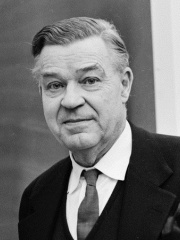
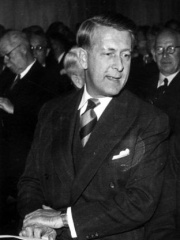
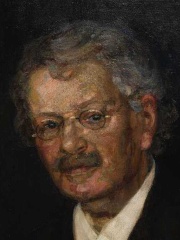
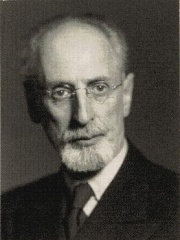
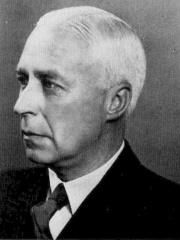
The Most Famous
ECONOMISTS from Sweden
This page contains a list of the greatest Swedish Economists. The pantheon dataset contains 414 Economists, 6 of which were born in Sweden. This makes Sweden the birth place of the 13th most number of Economists behind Türkiye, and Ukraine.
Top 6
The following people are considered by Pantheon to be the most legendary Swedish Economists of all time. This list of famous Swedish Economists is sorted by HPI (Historical Popularity Index), a metric that aggregates information on a biography's online popularity.

1. Gunnar Myrdal (1898 - 1987)
With an HPI of 73.52, Gunnar Myrdal is the most famous Swedish Economist. His biography has been translated into 72 different languages on wikipedia.
Karl Gunnar Myrdal ( MUR-dahl, MEER-; Swedish: [ˈɡɵ̌nːar ˈmy̌ːɖɑːl]; 6 December 1898 – 17 May 1987) was a Swedish economist and sociologist. In 1974, he received the Nobel Memorial Prize in Economic Sciences along with Friedrich Hayek for "their pioneering work in the theory of money and economic fluctuations and for their penetrating analysis of the interdependence of economic, social and institutional phenomena." When his wife, Alva Myrdal, received the Nobel Peace Prize in 1982, they became the fourth ever married couple to have won Nobel Prizes, and the first and only to win independent of each other (versus a shared Nobel Prize by scientist spouses). Myrdal is best known in the United States for his study of race relations, which culminated in his book An American Dilemma: The Negro Problem and Modern Democracy. The study was influential in the 1954 landmark U.S. Supreme Court decision Brown v. Board of Education. In Sweden, his work and political influence were important to the establishment of the Folkhemmet and the welfare state.

2. Bertil Ohlin (1899 - 1979)
With an HPI of 71.10, Bertil Ohlin is the 2nd most famous Swedish Economist. His biography has been translated into 56 different languages.
Bertil Gotthard Ohlin (Swedish: [ˈbæ̌ʈːɪl ʊˈliːn]) (23 April 1899 – 3 August 1979) was a Swedish economist and politician. He was a professor of economics at the Stockholm School of Economics from 1929 to 1965. He was also leader of the People's Party, a social-liberal party which at the time was the largest party in opposition to the governing Social Democratic Party, from 1944 to 1967. He served briefly as Minister of Commerce and Industry from 1944 to 1945 in the Swedish coalition government during World War II. He was President of the Nordic Council in 1959 and 1964. Ohlin's name lives on in one of the standard mathematical models of international free trade, the Heckscher–Ohlin model, which he developed together with Eli Heckscher. He was jointly awarded the Nobel Memorial Prize in Economic Sciences in 1977 together with the British economist James Meade "for their pathbreaking contribution to the theory of international trade and international capital movements".

3. Knut Wicksell (1851 - 1926)
With an HPI of 66.65, Knut Wicksell is the 3rd most famous Swedish Economist. His biography has been translated into 31 different languages.
Johan Gustaf Knut Wicksell (December 20, 1851 – May 3, 1926) was a Swedish economist of the Stockholm school. He was professor at Uppsala University and Lund University. He made contributions to theories of population, value, capital and money, as well as methodological contributions to econometrics. His economic contributions would influence both the Keynesian and Austrian schools of economic thought. He was married to the noted feminist Anna Bugge.

4. Eli Heckscher (1879 - 1952)
With an HPI of 62.94, Eli Heckscher is the 4th most famous Swedish Economist. His biography has been translated into 28 different languages.
Eli Filip Heckscher (24 November 1879 – 23 December 1952) was a Swedish political economist and economic historian who was a professor at the Stockholm School of Economics. He is known for the Heckscher–Ohlin theorem, an influential model of international trade that predicts that capital-abundant countries export capital-intensive goods, while labor-abundant countries export the labor-intensive goods.
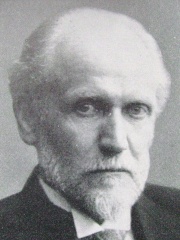
5. Gustav Cassel (1866 - 1945)
With an HPI of 62.42, Gustav Cassel is the 5th most famous Swedish Economist. His biography has been translated into 21 different languages.
Karl Gustav Cassel (20 October 1866 – 14 January 1945) was a Swedish economist and professor of economics at Stockholm University. Cassel was among the most prominent economists in the world in the interwar period. He made contributions to the study of value, monetary policy, and business cycles. Cassel was influential in Swedish debates about central planning in the early 20th century. Prior to World War I, Cassel held classical liberal views but shifted towards conservative liberalism in the interwar period. Cassel was a leading critic of socialism and state intervention in the economy.

6. Erik Lindahl (1891 - 1960)
With an HPI of 52.49, Erik Lindahl is the 6th most famous Swedish Economist. His biography has been translated into 15 different languages.
Erik Lindahl (21 November 1891 – 6 January 1960) was a Swedish economist. He was professor of economics at Uppsala University 1942–58 and in 1956–59 he was the President of the International Economic Association. He was an also an advisor to the Swedish government and the central bank, and in 1943 was elected as a member of the Royal Swedish Academy of Sciences. Lindahl posed the question of financing public goods in accordance with individual benefits. The quantity of the public good satisfies the requirement that the aggregate marginal benefit equals the marginal cost of providing the good. Lindahl's contributions to economic theory extend beyond his Wicksellian roots to embrace much of what is contained in modern Neo-Walrasian theory. Lindahl's formulation of the concept of sequence economies and intertemporal equilibrium (1929, 1930) is by far the first rigorous attempt to do so. Lindahl's couching of a theory of capital (1929, 1939) in intertemporal terms anticipates Malinvaud's (1953) famous attempt. The transfer of Lindahl's concepts to the anglophone world was accomplished by two of his most ardent supporters, John Hicks (1939, 1965) and Friedrich Hayek (1941). Since then, his work on "sequence analysis" has been given greater emphasis since the work of Frank Hahn (1973) and Roy Radner (1972). Lindahl's 1919 solution to the pricing of public goods is another noticeable achievement, brought into modern economics by Duncan Foley (1970).
People
Pantheon has 6 people classified as Swedish economists born between 1851 and 1899. Of these 6, none of them are still alive today. The most famous deceased Swedish economists include Gunnar Myrdal, Bertil Ohlin, and Knut Wicksell.
Deceased Swedish Economists
Go to all RankingsGunnar Myrdal
1898 - 1987
HPI: 73.52
Bertil Ohlin
1899 - 1979
HPI: 71.10
Knut Wicksell
1851 - 1926
HPI: 66.65
Eli Heckscher
1879 - 1952
HPI: 62.94
Gustav Cassel
1866 - 1945
HPI: 62.42
Erik Lindahl
1891 - 1960
HPI: 52.49
Overlapping Lives
Which Economists were alive at the same time? This visualization shows the lifespans of the 6 most globally memorable Economists since 1700.

